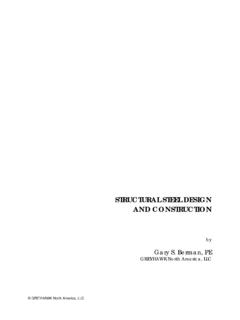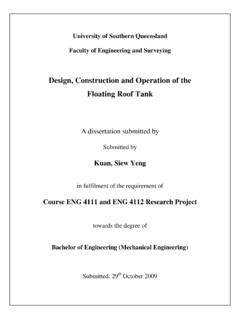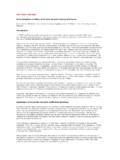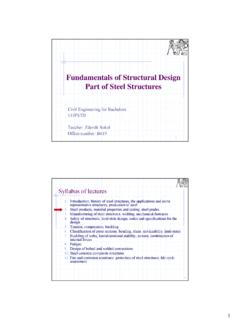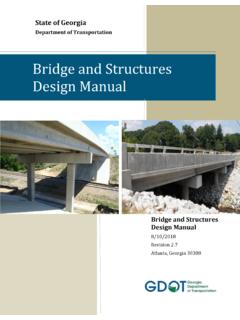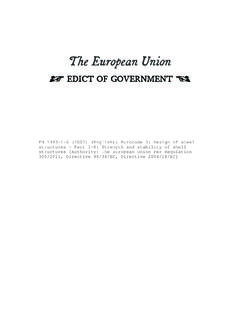Transcription of Structural Design of Steel Pipe Support Structures
1 Design issues for Structural engineersStructural DeSignSTRUCTURE magazineFebruary 2010 structure magazine6 Structural Design of Steel pipe Support StructuresBy Kasi V. Bendapudi, , is common to overemphasize the struc-tural Design of pipe Support Structures , rather than focus on detailing for stability or economics and practical aspects of the Steel structure and the foundations. This is sometimes referred to as over-designing and under-detailing . Sometimes the hanger-type pipe supports or the trapezes supported by another structure , such as the main building frame, are referred to as pipe Support Structures . For the pur-poses of this discussion, the terms pipe racks, pipe supports, and pipe Support Structures are interchangeable. Essential elements for limit states of pipe Support systems are often ignored, since these systems are comprised of secondary ele-ments and rarely impact the Structural integrity of any industrial failures of pipe supports are neither documented nor disseminated to the Structural community.
2 The Structural Design of pipe racks varies widely depend-ing upon the plant operations and the associated plant standards. However, pipe rack failures could cause serviceability problems for plant operations. Failures of pipe Support systems could potentially impact the health, welfare, and safety of plant personnel due to pipe breakage or leaks. The following discussion includes a review of the considerations involved in the Design , detailing, and Structural stability of pipe racks. Optimal solutions are still governed by the judgment of the Design of piping designIn general, pipes are designed to move freely on their supports in the longitudinal direction (along the axis of the pipe ), except at the anchor points. pipe anchor-ages are required to account for expansion and contraction of pipes due to variations in the ambient temperatures.
3 The expan-sion/contraction of pipes resulting from changes in temperature and pressure of the contents is taken into consideration by the piping engineers during piping Design . Anchor points will be required to maintain the pipes in a state of equilibrium. Expan-sion loops are also used to limit pipe stresses and the associated failures in the piping systems. The movements of the pipes occur due to expansion, contraction, and transient loads. System shutdowns and re-starts could also cause movements in the pipes. Transverse guides limit the lateral displacements of the effectsAmbient temperature differentials induce forces in both pipes and pipe supports. These forces are generally induced over a period of time if they are due to variations in the ambient temperature. However, the forces occur more rapidly if the thermal variations are affected by the contents in the pipes.
4 Particularly during the time of plant startups and shutdowns, these forces can occur rapidly. A pipe rack or a pipe Support is not typically subjected to noticeable punishment under seasonal temperature differentials, because it re-sponds like an accordion . Thermal variations due to the contents of the pipe result in anchor forces that are more severe Structural Steel pipe supports are extensively utilized in industrial and manufacturing facilities. Lack of uniform industry standards for this topic leads to each organization adopting its own engineering standards, at times, without a clear understanding of the underlying theoretical concepts and the cost implications. This is the first of a two-part series of articles on the behavior and Design of Steel Support Structures for pipes. This article (Part 1) discusses the effects of ambient temperature changes, expansion joint requirements, and an introduction to Design loads.
5 Part 2 concludes with the continu-ation of Design loads, structure stability concepts and detailing for stability ABOUTCLSYMM ABOUTCLTYPICAL LOCK-IN BRACEPREFERRED BRACEF igure 1: Vertical bracing view of 4 tier process pipe rack with longitudinal bracing. Courtesy of Midrex Corporation, Inc., Charlotte, F60 F50 F30 F 30 FDESIGN RANGE USED IN EXAMPLEMEAN TEMP. OF ERECTEDSTRUCTURE (ASSUMED)STRUCTUREERECTIONASSUMED CYCLICAL ANNUAL VARIATIONSIN ATMOSPHERIC TEMPERATURES+ t(EXPANSION DOMAIN) t(CONTRACTION DOMAIN)Figure 2: Thermal variations of T R U C T U R E magazineCopyrightFebruary 2010 structure magazineFebruary 2010 ADVERTISEMENT - For Advertiser Information, visit should be considered in the Design of the supporting effects of temperature change (expansion or contraction) occur with respect to the center of thermal stiffness of the structure .
6 As a matter of good practice, lock-in bracing (Figure 1) should be avoided. Such vertical bracing provided at the ends of the pipe rack structure , in any given straight segment of the structure , tends to restrain the thermal forces. On the other hand, if the vertical bracing is provided at the center or close to the center of the pipe rack structure , the accordion effect can be achieved in the Structural system. Expansion joints are not necessary for pipe rack Structures less than approximately 400 to 500 feet (125m to 155m) in length, if lock-in bracing is avoided. Failures of pipe rack struc-tures due to lack of expansion joints are rare, and no recorded evidence is readily coefficient of linear expansion ( ) is the change in the length, per unit length, for a change of one degree of temperature.
7 The thir-teenth edition of the AISC Steel Construction Manual recommends a value of for each degree Fahrenheit (F) as a reasonable approximation of the coefficient of thermal expansion for temperatures less than 100 degrees change in length l = tl Equation 1 Where l is the original length of the member and t is the change in force imparted (P) due to restraint of free thermal expansion ( l)P = AE ( l)/l Equation 2 Substituting tl for l in Equation 2 the change in stress (psi) is expressed as = E t Equation 3P = A = A E t , Equation 4where A is the cross-sectional area of the metrics for establishing ambient temper-ature differential are to some extent subjective and should be based on recorded historical data of the atmospheric temperature conditions, preferably site-specific. The variations in the seasonal temperature with respect to the in-place condition of the structure need not be more than 80 F at most locations of the struc-tural systems (Figure 2).
8 A similar temperature gradient diagram should be established for each project of 80 F in temperature would cause an elongation (Equation 1) of approxi-mately 1/8-inch in a 20-foot-long Structural member and, if fully restrained, would cause a stress of ksi (Equation 3). For a pipe rack longitudinal beam (W12x26), the inter-nal force induced to restrain the elongation would be 116 kips (Equation 4). Design con-siderations should be segregated between the Design of the piping for its own movements and the Design of pipe rack Steel for the effects of variations in the ambient conditions. The movements of pipes during the operating conditions, or at the time of startups and shutdowns, could either happen in the ex-pansion domain or the contraction domain (Figure 2). Any attempt to establish a Design basis for the pipe rack Steel to combine both of these effects occurring concurrently is very cumbersome and attempt to restrain such forces at each frame of the pipe rack would also be imprac-tical and uneconomical.
9 Therefore, lock-in bracing as shown in Figure 1 should be avoided. For example, in a 440-foot-long stretch of pipe rack with frames spaced 20 feet apart, the middle two frames should be braced in accordance with the preferred method as shown in Figure 1. In this arrangement, the extreme column would be displaced approximately inches ( x 10 bays) at the top in the longitu-dinal direction. Column slope caused by this expansion is H/480 for a column height of 50 feet. Typically, longitudinal drift will not cause serviceability problems. There are no codes or industry standards that prescribe limits on lon-gitudinal drift. For long stretches of pipe racks, the pipe stress engineer should be consulted for any special requirements for longitudinal drift control. As a matter of interest, Process In-dustry Practice (PIP) Structural Design Criteria 2007 (STC 01015) limits transverse drift of the pipe rack bents to H/100, which is very lenient.
10 Therefore, the column displacement at the top is not significant, and the structure should be allowed to expand and contract due to the variations of the ambient temperatures. The total column displacements would be re-duced along the longitudinal direction (see in Figure 3) if the column bases are fixed in the longitudinal direction; however, this is neither a common practice nor necessary. No expan-sion joints in the pipe racks are necessary for rack lengths less than 500 feet (approximately 155m). Under such provisions (Figure 3), the structure is considered stable and serviceable. SYMM ABOUTCOMPRESSION BRACE10 BAYS @ 20 = 200 DISPLACEMENTAT POINT A @ COL. LINE 1 H / 480A(~ 16 m)H=50 010 BAYS @ 20 = 200 OF BRACINGAND THERMAL STIFFNESSCL1234567891011121314 Figure 3: Partial elevation of pipe rack with no expansion y fo F i b r w r ap S y s t e m ed to NSF/ANSI 61 Over 20 years ago we created the we set the standardStructural Strengthening FRP Installation Seismic Upgrade Blast Mitigation Concrete Retrofi t Specialty Gunite Underwater & Coastal Repairs Expansion & Seismic JointsPipe Repair and Renewal Large and Small Diameter PCCP, RCP, Steel Structural Repairs Carbon Fiber Structural LinersConcrete Restoration Epoxy Crack Injection Spall Repair Corrosion ProtectionAdvanced Fire Protection8380 Miralani Drive, San Diego, CA 92126 Tel: Fax.
